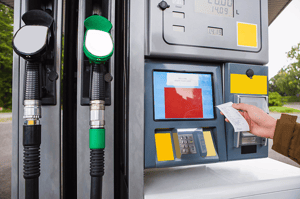How to Prevent Common Fuel Card Problems

 With the many advantages that fuel cards can provide, including improved efficiency and productivity, it’s easy to understand why fleet managers are increasingly turning to fuel cards as an attractive cost savings and management tool. Not only can fuel cards help fleet managers reduce fuel costs, with volume savings on monthly purchases and at-the-pump discounts, they can also help fleet managers gain greater control over fuel, maintenance and administrative expenses, with detailed line-by-line reporting capabilities.
With the many advantages that fuel cards can provide, including improved efficiency and productivity, it’s easy to understand why fleet managers are increasingly turning to fuel cards as an attractive cost savings and management tool. Not only can fuel cards help fleet managers reduce fuel costs, with volume savings on monthly purchases and at-the-pump discounts, they can also help fleet managers gain greater control over fuel, maintenance and administrative expenses, with detailed line-by-line reporting capabilities.
If this sounds too good to be true, it’s not. On top of all the advantages they provide, fleet cards are also convenient and easy to use. But, here’s the thing -- to reap the benefits, there are a couple of things to be aware of.
First, do not dive head-first into a fuel card program. Getting the greatest ROI means working with a provider to discuss the best options for your fleet, preparing your workforce for your program launch, addressing questions and concerns after launch and tweaking your program, if necessary.
The second thing ties somewhat into the first, and that’s preventing common problems associated with fuel cards. The good news is two of the most common problems— fraud and cards getting declined —can be prevented or quickly fixed by following some basic tips.
Let’s take a closer look at each of those.
Fuel Card Fraud
Preventing fuel card fraud from happening in the first place is an ideal strategy. The key is to develop a fraud prevention strategy that educates drivers on the risks and vulnerabilities associated with fraud and defines misuse, slippage and outright fraud. Some examples:
- Misuse: Fueling a personal vehicle or that of a family member or friend.
- Slippage: Purchasing non-fuel items, such as snacks and drinks, but reporting it as a fuel purchase.
- Fraud: Stolen and skimmed card data by a third-party.
When setting up a card program with a provider, there are controls that can be established to help prevent misuse, slippage and fraud. However, be aware that these are not 100% fail proof. While controls can restrict purchase type, number of transactions, dollar limits, purchase frequency and time, it’s also necessary to follow some basic fraud prevention tips to ensure you are doing all you can to prevent fraud from occurring. This includes:
- Requiring drivers to enter their PIN and then prompting them to enter other verification data, such as a unit number, before they are able to pump fuel.
- Encouraging drivers to look for signs of pump tampering and, if anything looks out of sorts, to use another pump. Also, stress fill-ups at stations with surveillance cameras.
- Regularly monitoring fuel card accounts, with particular attention to charges with unusual dollar amounts, from unusual geographical locations and atypical frequency of fill-ups.
- Making drivers aware of credit card skimming devices by checking that card readers/set-ups at all pumps look identical. If they don’t match, drivers should not use the pump and contact the attendant. It’s best to use the pump closest to the store, since that is the least likely pump to have a device.
- Stressing that card misuse is illegal and could be grounds for termination.
Cards Declined
Getting a call from a driver that their fuel card was declined does not make for a very good day. Time is wasted figuring out the reason the card was declined, and then the card must be reset before the driver can get back on the job — a huge productivity drain and a not-so-happy waiting game for customers. But, it doesn’t have to be this way. If cards are declined, the fix can be simple and quick.
The most common reasons cards are declined are:
- Driver entering the wrong PIN number
- Driver attempting to fuel outside of the fuel card limits
- Fuel card not accepted where the driver is trying to purchase fuel
And, here’s the quick fix:
- Wrong PIN Number: Have a spreadsheet with the PIN number of every fuel card on your phone or other mobile device, so it is with you at all times.
- Fueling Outside of Limits: As with the PIN number, keep a spreadsheet on your phone or mobile device of the controls/restrictions of every card. If you need to make a change so a driver can buy fuel, you can handle that quickly by logging into your account or contacting your card provider.
- Not Accepted at Location: If your drivers have universal cards, this should rarely be a problem, since cards are accepted most anywhere. That said, should a problem occur, most fuel card companies have mobile apps, so drivers can find the closest accepting location.
As with many business initiatives, problems can pop up; fuel cards are no different. But, with careful planning, workforce education and a watchful eye on fuel expense statements for anomalies, should problems occur, they can be quickly nipped in the bud. The benefits of fuel cards far outweigh the negative. So, if you haven’t already, it’s time to get with a program.
Interested in learning more about best practices when it comes to fuel? Check out our fuel efficiency white paper.